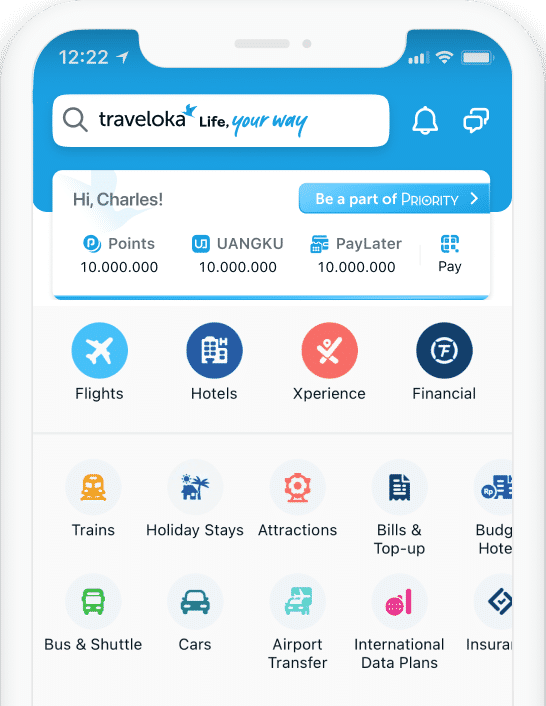
Hotels in Da Nang
Destinations to Discover






Why Pay More
When You Can Pay Less?

Popular Hotels in Da Nang
Discover what you like
Stay near exciting spots
Plenty of options, whatever your occasion
Đăng ký để sử dụng coupon
8% giảm giá Khách sạn
Giảm ngay 50K
8% giảm Hoạt động Du lịch
12% giảm Đưa đón sân bay
10% giảm Thuê xe
More about Da Nang
Introduction
Da Nang, a vibrant coastal city in central Vietnam, is a popular destination known for its stunning beaches, rich cultural heritage, and dynamic cityscape. Whether you’re relaxing on the sandy shores of My Khe Beach, exploring the famous Marble Mountains, or marveling at the architectural wonders of the Golden Bridge, Da Nang offers something for every traveler. Finding the perfect hotel in Da Nang is essential for an unforgettable trip, ensuring you’re well-placed to enjoy the city’s attractions, culinary delights, and serene ambiance. This guide will help you choose the best accommodations and explore the wonders of Da Nang.
Why Visit Da Nang?
Da Nang is renowned for its pristine beaches, picturesque landscapes, and welcoming locals. It serves as a gateway to UNESCO World Heritage Sites like Hoi An Ancient Town and My Son Sanctuary, making it an ideal base for cultural and historical exploration. The city also boasts a lively nightlife, vibrant street food culture, and numerous outdoor activities, including hiking, water sports, and sightseeing. Whether you’re looking for relaxation, adventure, or cultural immersion, Da Nang has it all.
How to Book a Hotel in Da Nang at a Good Price
Use Traveloka for Easy Booking
Traveloka is a reliable platform for finding the best hotels in Da Nang. From beachfront resorts to budget-friendly stays, Traveloka offers a wide range of options with competitive prices. You can take advantage of flash sales, exclusive app promotions, and verified reviews to make an informed choice.
Book During the Right Season
The best time to visit Da Nang is during the dry season, from February to August, when the weather is warm and sunny. To secure better rates, consider traveling during the shoulder months of February or September, when the weather is still pleasant but prices are more affordable.
Plan Ahead and Stay Flexible
Advance booking ensures you get the best deals, especially for popular hotels near My Khe Beach or the city center. Many accommodations offer free cancellation policies, allowing you to adjust your plans if needed.
Where to Stay in Da Nang
Da Nang offers diverse accommodation options to suit different preferences, budgets, and travel purposes. Here’s a breakdown of the best areas to stay:
My Khe Beach: Beachfront Luxury
My Khe Beach, often listed among the world’s most beautiful beaches, is a prime location for visitors seeking relaxation and stunning ocean views. The area is home to numerous upscale resorts and mid-range hotels with direct beach access.
- Luxury Hotels:InterContinental Danang Sun Peninsula Resort offers world-class amenities and panoramic ocean views, while Furama Resort Da Nang provides a luxurious retreat with beachfront villas and fine dining.
- Mid-Range Hotels:Sala Danang Beach Hotel and Grand Mercure Danang are great options for affordable comfort.
- Who It’s For: Perfect for beach lovers, families, and honeymooners.
City Center: Convenience and Culture
Staying in Da Nang’s city center gives you easy access to local attractions, shopping areas, and cultural landmarks. It’s an ideal base for exploring Han Market, Dragon Bridge, and the bustling streets of Da Nang.
- Top Hotels:Novotel Danang Premier Han River offers modern luxury and river views, while Sanouva Danang Hotel provides a boutique experience.
- Who It’s For: Ideal for business travelers, solo adventurers, and those seeking a blend of convenience and culture.
Son Tra Peninsula: Nature and Serenity
For travelers looking to escape the city’s hustle, Son Tra Peninsula is a peaceful haven. Known as “Monkey Mountain,” this area is perfect for nature lovers and outdoor enthusiasts.
- Recommended Hotels:Son Tra Resort offers private beachfront villas, while Naman Retreat provides eco-luxury surrounded by lush greenery.
- Who It’s For: Best for nature enthusiasts, couples, and those seeking tranquility.
Hoi An Gateway: A Blend of City and Heritage
Located just 30 kilometers from Hoi An Ancient Town, staying near the Da Nang-Hoi An border offers easy access to both destinations. This area is ideal for travelers planning to explore both the city and its cultural surroundings.
- Recommended Hotels:Sheraton Grand Danang Resort and Vinpearl Resort & Spa Da Nang provide luxurious stays with proximity to both Da Nang and Hoi An.
- Who It’s For: Perfect for culture seekers and those looking for a central location between two iconic destinations.
Best Places to Eat in Da Nang
Da Nang is a culinary paradise offering everything from authentic Vietnamese street food to international fine dining. The city’s vibrant food scene reflects its coastal heritage and modern flair.
Street Food Delights
Da Nang’s street food is a must-try for every visitor. Popular dishes include mi quang (turmeric noodles), banh xeo (Vietnamese pancakes), and bun cha ca (fish cake noodle soup). For fresh seafood, visit the roadside stalls along My Khe Beach.
Local Restaurants
For a sit-down experience, Madame Lan Restaurant offers traditional Vietnamese cuisine in a charming setting. Tam’s Pub and Surf Shop is another favorite, serving both local dishes and Western comfort food.
Cafés and Desserts
Da Nang has a thriving café culture, with trendy spots like Cong Caphe offering vintage vibes and specialty coffee. For dessert lovers, Loving Vegan Dessert offers creative treats, while Banh Mi Baguette serves delightful pastries.
Best Places to Visit in Da Nang
Da Nang is packed with attractions that showcase its natural beauty, cultural richness, and modern charm.
Marble Mountains
The Marble Mountains are a cluster of five limestone hills, each representing an element—fire, water, earth, metal, and wood. Explore caves, pagodas, and breathtaking viewpoints.
Dragon Bridge
Dragon Bridge, a modern architectural marvel, lights up in vibrant colors at night. On weekends, it features a fire and water show, making it a popular attraction.
Ba Na Hills and the Golden Bridge
Ba Na Hills is a mountain resort featuring the iconic Golden Bridge, supported by giant stone hands. The area also includes a French Village, gardens, and a cable car with panoramic views.
Son Tra Peninsula
Son Tra Peninsula is home to the Linh Ung Pagoda, a giant Lady Buddha statue overlooking the bay. The area offers hiking trails and pristine beaches.
My Khe Beach
Renowned for its soft white sand and clear waters, My Khe Beach is perfect for swimming, sunbathing, and water sports.
Best Time to Visit Da Nang
Da Nang’s tropical climate makes it a year-round destination, but understanding the seasonal variations can help you plan the perfect trip. The city experiences two main seasons: the dry season and the rainy season. Each season offers unique advantages and experiences, depending on your travel preferences.
Dry Season (February to August)
The dry season is the most popular time to visit Da Nang. During this period, the weather is warm, sunny, and perfect for outdoor activities. Average temperatures range from 25°C to 35°C (77°F to 95°F), with minimal rainfall and plenty of sunshine. This is the ideal time to explore Da Nang’s beaches, such as My Khe Beach and Non Nuoc Beach, which are known for their soft sand and clear waters. Water sports like jet skiing, parasailing, and kayaking are also in full swing during these months.
Spring months, particularly February and March, offer cooler and more pleasant weather, making them perfect for sightseeing at landmarks like the Marble Mountains, Linh Ung Pagoda, and the Dragon Bridge. As the season progresses, April through June sees warmer temperatures, attracting beachgoers and sun lovers. July and August mark the peak of summer, with bustling beaches and vibrant nightlife along the coastline.
Rainy Season (September to January)
The rainy season in Da Nang begins in September and lasts until January. This period is characterized by frequent rainfall, with occasional storms and typhoons in October and November. Despite the rain, there are still many reasons to visit Da Nang during this time. The cooler weather, ranging from 20°C to 25°C (68°F to 77°F), creates a cozy atmosphere ideal for exploring indoor attractions such as museums, local markets, and cafés.
The rainy season is also the off-peak period for tourism, meaning fewer crowds at major attractions and significant discounts on hotels, tours, and flights. If you don’t mind the occasional downpour, this season offers a more tranquil experience. Additionally, the lush greenery of the surrounding landscapes becomes even more vibrant, enhancing the beauty of places like Ba Na Hills and Son Tra Peninsula.
Festivals and Events
Timing your visit around Da Nang’s festivals can add a unique cultural experience to your trip. The Da Nang International Fireworks Festival, usually held between April and June, is a spectacular event featuring pyrotechnic displays from teams around the world. Tet, the Vietnamese Lunar New Year, celebrated in January or February, transforms the city with vibrant decorations, traditional performances, and festive markets.
Things to Know When Traveling to Da Nang
Da Nang is a traveler-friendly destination that combines natural beauty, cultural richness, and modern amenities. To ensure a smooth and enjoyable trip, it’s important to familiarize yourself with some key aspects of traveling to this vibrant city.
Transportation in Da Nang
Getting around Da Nang is convenient thanks to its well-developed transportation network. The city’s international airport, Da Nang International Airport, is a major gateway for both domestic and international flights. From the airport, you can easily reach the city center or your hotel by taxi, Grab (a popular ride-hailing app), or shuttle services.
Within the city, taxis and motorbike rentals are common modes of transportation. Taxis are metered and reliable, with reputable companies like Mai Linh and Vinasun. Renting a motorbike is an excellent way to explore Da Nang at your own pace, especially for visiting nearby attractions like Son Tra Peninsula and the Marble Mountains. However, ensure you have a valid license and drive cautiously.
Currency and Payment
The Vietnamese Dong (VND) is the official currency in Da Nang. While cash is widely used, credit cards are accepted at most hotels, restaurants, and shopping malls. ATMs are readily available throughout the city for convenient withdrawals. It’s advisable to carry smaller denominations of cash for purchases at local markets and street vendors, as they may not accept cards or larger bills.
Cultural Etiquette
Understanding and respecting local customs will enhance your experience in Da Nang. When visiting temples and pagodas, dress modestly by covering your shoulders and knees. Always remove your shoes before entering religious sites or someone’s home. When greeting locals, a smile and a polite “Xin chào” (hello) are appreciated.
Vietnamese culture emphasizes respect and harmony. Avoid raising your voice or displaying frustration in public. Additionally, refrain from discussing sensitive topics such as politics or religion, as these can be considered impolite.
Food and Water Safety
Da Nang is famous for its fresh seafood and local specialties like mi quang (turmeric noodles) and banh xeo (Vietnamese pancakes). Street food is safe to try, especially from busy vendors with high turnover. Always choose freshly prepared dishes and avoid food that has been sitting out for extended periods. For hydration, stick to bottled or filtered water, which is widely available and affordable.
Shopping and Bargaining
Local markets like Han Market and Con Market are great places to shop for souvenirs, clothes, and local produce. Bargaining is common in markets, so don’t hesitate to negotiate politely for a better price. In shopping malls and upscale stores, prices are fixed.
Emergency Contacts and Health Precautions
Da Nang is a safe city, but it’s always wise to take precautions. Keep your belongings secure, especially in crowded areas like markets or festivals. For medical emergencies, international-standard clinics and hospitals are available in the city. It’s recommended to have travel insurance that covers medical expenses.
Useful Travel Tips
Plan your day around the weather, especially during the rainy season, by scheduling outdoor activities in the morning when rain is less likely. Learn a few basic Vietnamese phrases to connect with locals and enhance your travel experience. Download apps like Google Maps and Grab to navigate the city easily and book transportation.
By keeping these tips in mind, you’ll be well-prepared to explore the beauty, culture, and excitement that Da Nang has to offer. Whether you’re visiting for relaxation, adventure, or cultural discovery, this coastal city promises an unforgettable experience.
Facts about hotel in Da Nang
Total Accommodation | 1,404 Properties |
Popular City | Son Tra District, My An Ward |
Popular Hotel | Hyatt Regency Danang Resort and Spa, Risemount Premier Resort Danang |
Popular Landmark | My Khe Beach, Jembatan Sungai Han |
Frequently asked questions

Guest reviews in hotel near Da Nang
Why book Accommodation in Traveloka?



We’ve got more than just hotels












































 Facebook
Facebook Instagram
Instagram TikTok
TikTok Youtube
Youtube Telegram
Telegram